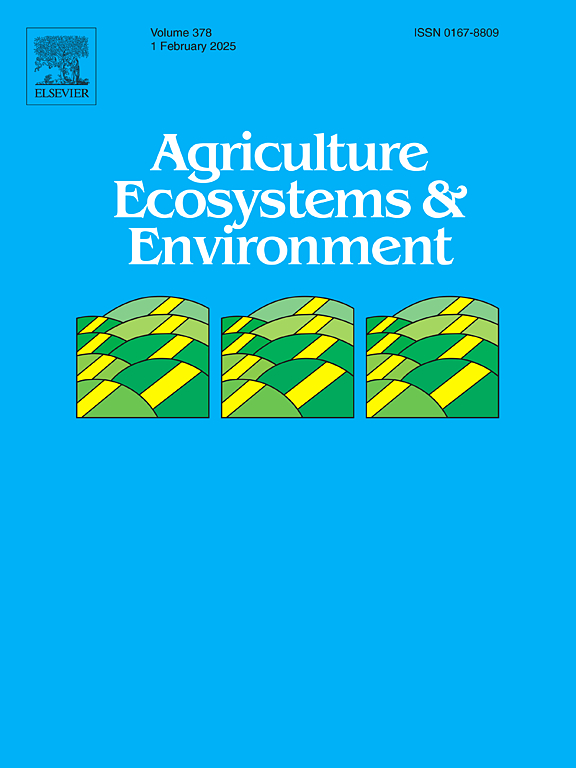Agricultural land lacks resistance to water erosion during the wettest winters of the past decade
IF 6.4
1区 农林科学
Q1 AGRICULTURE, MULTIDISCIPLINARY
引用次数: 0
Abstract
With changing climate and increased frequency of wet weather extremes, increased attention is being directed towards understanding the resilience of agroecosystems and the goods and services they deliver. The world's most instrumented and monitored farm (the North Wyke Fam Platform - a UK National Bioscience Research Infrastructure) has been used to explore the resilience of sediment loss regulation delivered by lowland grazing livestock and arable systems under conventional best management. The robustness of water quality regulation was explored using exceedance of modern background (i.e. pre-World War II) net soil loss rates (i.e., sediment delivery) during both typical (2012–13, 2015–16) and the most extreme (2013–14, 2019–20, 2023–24) winters (December - February, inclusive), in terms of seasonal rainfall totals, over the past ∼decade. Exceedances of maximum modern background sediment loss rates from pasture were as high as 2.4X when scheduled ploughing and reseeding for sward improvement occurred immediately prior to the winters in question. Exceedances of maximum modern background sediment loss rates in the arable system (winter wheat and spring oats) were as high as 21.7X. Over the five monitored winters, the environmental damage costs for cumulative sediment loss from the permanent pasture system ranged from £ 163–203 and £ 197–245 ha−1 to £ 321–421 and £ 386–507 ha−1. Over the same five winters, environmental damage costs for cumulative sediment loss from catchments subjected to reseeding and, more latterly, arable conversion, ranged between £ 382–584 and £ 461–703 ha−1 to £ 1978–2334 and £ 2384–2812 ha−1. Our data provide valuable quantitative insight into the impacts of winter rainfall and land use on the resilience of sediment loss regulation.
在过去十年最潮湿的冬季,农业用地缺乏对水侵蚀的抵抗力
随着气候变化和极端潮湿天气频率的增加,人们越来越重视了解农业生态系统的复原力及其提供的商品和服务。世界上仪器化和监测最多的农场(North Wyke Fam平台-英国国家生物科学研究基础设施)已被用于探索传统最佳管理下低地放牧牲畜和耕地系统对沉积物损失调节的弹性。就过去10年的季节性降雨总量而言,利用典型(2012-13年、2015-16年)和最极端(2013-14年、2019-20年、2023-24年)冬季(12月至2月,包括在内)的现代背景(即二战前)净土壤流失率(即沉积物输送)的超出情况,探讨了水质调节的稳健性。当为改良草地而进行的计划耕作和补种在有关冬季之前立即发生时,牧场的最大现代背景沉积物损失率超过了2.4倍。耕地系统(冬小麦和春燕麦)的最大现代背景泥沙损失率超出了21.7倍。在监测的5个冬季,永久牧场系统累积泥沙损失的环境损害成本为 163-203英镑和 197-245英镑 ha - 1, 321-421英镑和 384 - 507英镑 ha - 1。在同样的5个冬季,由于重新播种和后来的耕地改造而造成的集水区累积沉积物损失的环境损害成本在 382-584英镑和 461-703英镑 ha - 1到 1978-2334英镑和 2384-2812英镑 ha - 1之间。我们的数据为冬季降雨和土地利用对泥沙损失调节弹性的影响提供了有价值的定量见解。
本文章由计算机程序翻译,如有差异,请以英文原文为准。
求助全文
约1分钟内获得全文
求助全文
来源期刊

Agriculture, Ecosystems & Environment
环境科学-环境科学
CiteScore
11.70
自引率
9.10%
发文量
392
审稿时长
26 days
期刊介绍:
Agriculture, Ecosystems and Environment publishes scientific articles dealing with the interface between agroecosystems and the natural environment, specifically how agriculture influences the environment and how changes in that environment impact agroecosystems. Preference is given to papers from experimental and observational research at the field, system or landscape level, from studies that enhance our understanding of processes using data-based biophysical modelling, and papers that bridge scientific disciplines and integrate knowledge. All papers should be placed in an international or wide comparative context.
 求助内容:
求助内容: 应助结果提醒方式:
应助结果提醒方式:


